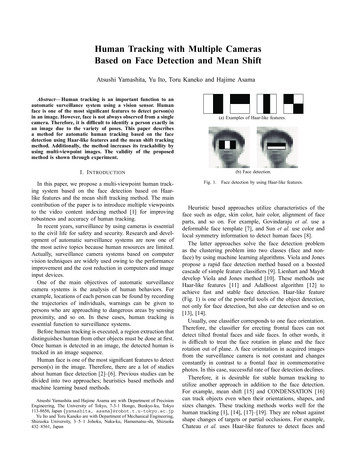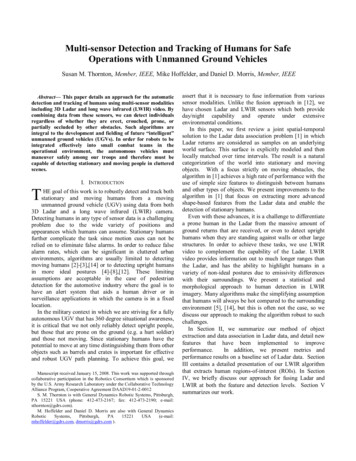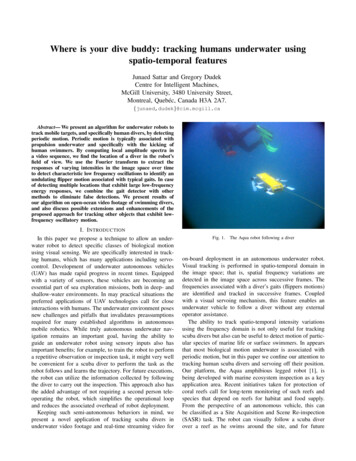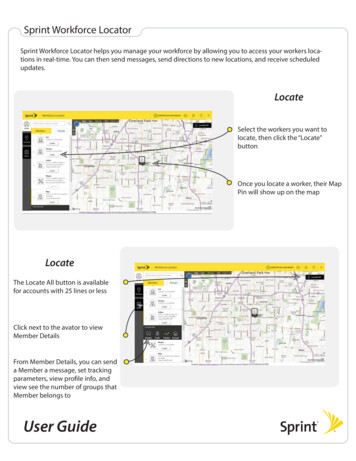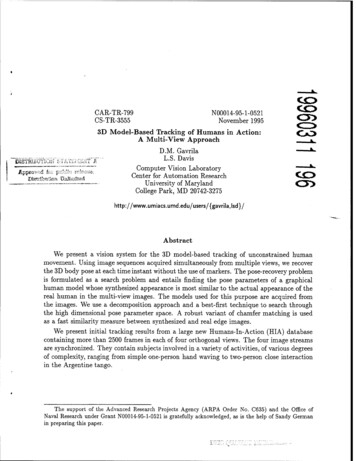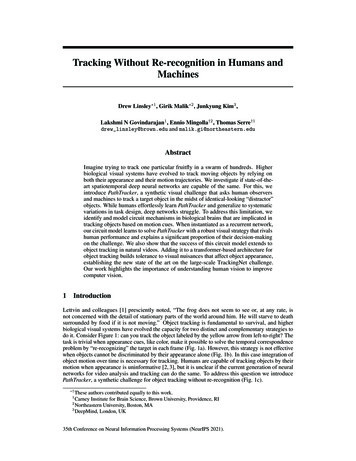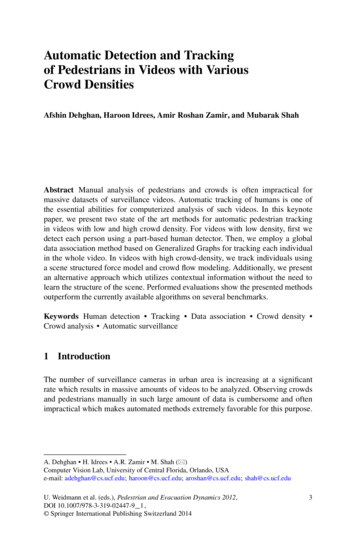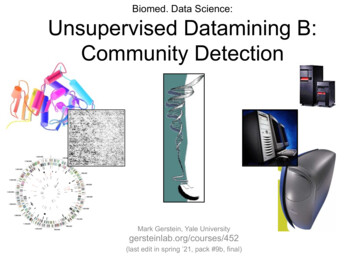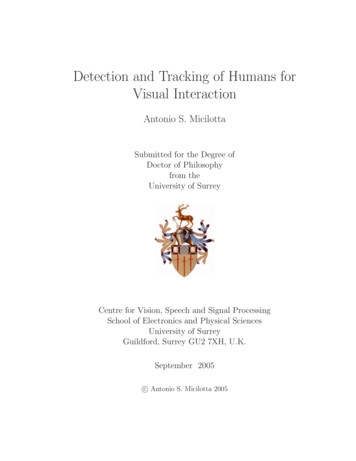
Transcription
Detection and Tracking of Humans forVisual InteractionAntonio S. MicilottaSubmitted for the Degree ofDoctor of Philosophyfrom theUniversity of SurreyCentre for Vision, Speech and Signal ProcessingSchool of Electronics and Physical SciencesUniversity of SurreyGuildford, Surrey GU2 7XH, U.K.September 2005c Antonio S. Micilotta 2005
AbstractThis thesis contributes, in essence, four developments to the field of computervision. The first two present independent methods of locating and tracking bodyparts of the human body, where the main interest is not 3D biometric accuracy,but rather a sufficient discriminatory representation for visual interaction. Making use of a single uncalibrated camera, the first algorithm employs backgroundsuppression and a general approximation to body shape, applied within a particlefilter framework. In order to maintain real-time performance, integral images areused for rapid computation of particles. The second method presents a probabilistic framework of assembling detected human body parts into a full 2D humanconfiguration. The face, torso, legs and hands are detected in cluttered scenesusing body part detectors trained by AdaBoost. Coarse heuristics are appliedto eliminate obvious outliers, and body configurations are assembled from theremaining parts using RANSAC. An a priori mixture model of upper-body configurations is used to provide a pose likelihood for each configuration, after whicha joint-likelihood model is determined by combining the pose, part detector andcorresponding skin model likelihoods; the assembly with the highest likelihood isselected.The third development is applied in conjunction with either of the aforementionedhuman body part detection and tracking techniques. Once the respective bodyparts have been located, the a priori mixture model of upper-body configurationsis used to disambiguate the hands of the subject. Furthermore, the likely elbowpositions are statistically estimated, thereby completing the upper body pose.A method of estimating the 3D pose of the upper human body from a singlecamera is presented in the final development. A database consisting of a varietyof human movements is constructed from human motion capture data. Thismotion capture data is then used to animate a generic 3D human model which isrendered to produce a database of frontal view images. From this image database,three subsidiary databases consisting of hand positions, silhouettes and edge mapsare extracted. The candidate image is then matched against these databases inreal time. The index corresponding to the subsidiary database triplet that yieldsthe highest matching score is used to extract the corresponding 3D configurationfrom the motion capture data. This motion capture frame is then used to extractthe 3D positions of the hands for use in HCI, or to render a 3D model.
AcknowledgementsParticular appreciation goes to Richard Bowden who has offered much wisdomand guidance over the passed three years. Having a young, energetic supervisorhas often filled me with inspiration and enthusiasm. Eng Jon Ong has also offeredgreat input; working with him brought on a sense of team work which motivatedme to do more. My parents and sister have offered a world of support, andthe encouragement and faith to push forward when times were tough. Lastly,great appreciation goes to the Centre for Vision, Speech and Signal Processingfor providing a studentship and the opportunity to continue my education in aworld class facility.
List of Publications1. A.S. Micilotta, E.J. Ong and R.Bowden. Real-time Upper Body Detectionand 3D Pose Estimation in Monoscopic Images. Submitted to ECCV forreview in September 2005.2. A.S. Micilotta, E.J. Ong and R.Bowden. Human Body Part Detection andTracking. Submitted to PAMI for review in August 2005.3. E.J. Ong, A. Hilton, A.S. Micilotta. Viewpoint Invariant Exemplar-Based3D Human Tracking. To appear in Proceedings on Modeling People andHuman Interaction Workshop, October, 2005.4. A.S. Micilotta, E.J. Ong and R.Bowden. Human Body Part Detection andTracking. In Hans-Helmut Nagel, editor, Cognitive Vision Systems, to bepublished in 2005.5. A.S. Micilotta, E.J. Ong and R.Bowden. Detection and Tracking of Humansby Probabilistic Body Part Assembly. In proceedings on British MachineVision Conference, volume 1, pages 429-438, September 2005.6. A.S. Micilotta, E.J. Ong and R.Bowden. Real-time Upper Body 3D PoseEstimation from a Single Uncalibrated Camera. In proceedings on Eurographics, Short Presentations, pages 41-44, August 2005.7. A.S. Micilotta and R.Bowden. View-based Location and Tracking of BodyParts for Visual Interaction. In proceedings on British Machine VisionConference, volume 2, pages 849-858, September 2004.8. A.S. Micilotta and R.Bowden. View-based Location and Tracking of BodyParts for Visual Interaction. In BMVA Symposium on Spatio-temporalImage Processing, March 2004.
NomenclatureGMMGaussian Mixture ModelHCIHuman Computer InteractionPCAPrincipal Components AnalysisPDFProbability Density FunctionPDMPoint Distribution ModelCMYKThe Cyan, Magenta, Yellow and Black colour modelused in standard colour printingHSIHue, Saturation, IntensityHSVHue, Saturation, ValueRGBRed, Green, BlueYCbCrLuminance and ChrominanceGround truthThe manual marking of interesting features, for examplemarking the locations of a subjects hands throughout avideo sequenceA priori modelA statistical representation of the ground truthReal timeA software application that processes data greater than25 frames per secondOn lineProcesses which are actioned while the software application is runningOff lineProcesses which occur prior to the initialisation of thesoftware application. Typical processes included groundtruthing, training and database constructionSVMSupport Vector MachineRVMRelevance Vector Machine
x
Contents1 Introduction12 Literature Review52.1 Modelling the Background . . . . . . . . . . . . . . . . . . . . . .52.2 Modelling the Foreground . . . . . . . . . . . . . . . . . . . . . .92.2.1View Based 2D Detection and Tracking . . . . . . . . . . .92.2.2Model Based 3D Human Reconstruction . . . . . . . . . .142.2.3Body Part Detection using Specific Detectors . . . . . . .173 Tracking Human Body Parts Using Particle Filters213.1 Bayes’ Rule . . . . . . . . . . . . . . . . . . . . . . . . . . . . . .223.2 Particle Filtering - A Graphical Example . . . . . . . . . . . . . .223.3 Tracking Human Body Parts - The System Overview . . . . . . .283.4 Background Suppression . . . . . . . . . . . . . . . . . . . . . . .303.4.1Chroma-Keying . . . . . . . . . . . . . . . . . . . . . . . .303.4.2Adaptive Background Suppression . . . . . . . . . . . . . .303.5 Tracking using manually designed body part primitives . . . . . .313.5.1Computation of a particle’s fitness. . . . . . . . . . . . .333.5.2Tracking the Torso . . . . . . . . . . . . . . . . . . . . . .353.5.3Tracking the face and hands . . . . . . . . . . . . . . . . .383.6 Integral Images for Real-Time Performance . . . . . . . . . . . . .433.6.1Integral image benefit. . . . . . . . . . . . . . . . . . . .xi46
xiiContents3.73.8Results . . . . . . . . . . . . . . . . . . . . . . . . . . . . . . . . .473.7.1Chroma-keying . . . . . . . . . . . . . . . . . . . . . . . .473.7.2Adaptive background segmentation . . . . . . . . . . . . .483.7.3Determining the Optimal Population Size. . . . . . . . .503.7.4Tracking Robustly in Cluttered Scenes . . . . . . . . . . .52Conclusions . . . . . . . . . . . . . . . . . . . . . . . . . . . . . .574 Prior Data for Pose Estimation594.1Gaussian Mixture Model Construction . . . . . . . . . . . . . . .594.2Disambiguating the Hands . . . . . . . . . . . . . . . . . . . . . .624.3Estimation of Elbow Positions . . . . . . . . . . . . . . . . . . . .644.4Results . . . . . . . . . . . . . . . . . . . . . . . . . . . . . . . . .654.5Conclusions . . . . . . . . . . . . . . . . . . . . . . . . . . . . . .665 Detection and Tracking of Humans by Probabilistic Body PartAssembly695.15.25.35.4Object Detection . . . . . . . . . . . . . . . . . . . . . . . . . . .705.1.1Features . . . . . . . . . . . . . . . . . . . . . . . . . . . .705.1.2Training the Classifier . . . . . . . . . . . . . . . . . . . .725.1.3Applying the Trained Detector. . . . . . . . . . . . . . .75Boosted Body Parts Detectors . . . . . . . . . . . . . . . . . . . .755.2.1Exploiting Colour Cues for Reduced False Detections . . .76Human Body Assembly . . . . . . . . . . . . . . . . . . . . . . . .785.3.1False Part Elimination using Coarse Heuristics . . . . . . .795.3.2Determining a Pose Likelihood . . . . . . . . . . . . . . . .815.3.3Final Configuration Selection . . . . . . . . . . . . . . . .825.3.4Estimation of Elbow Positions . . . . . . . . . . . . . . . .835.3.5Detection in Sequences with a Static Background . . . . .835.3.6Overcoming Occlusions . . . . . . . . . . . . . . . . . . . .84Results . . . . . . . . . . . . . . . . . . . . . . . . . . . . . . . . .85
Contentsxiii5.4.1Body Part Detector Performance . . . . . . . . . . . . . .855.4.2Body Part Detection and Assembly in Images . . . . . . .875.4.3Detection and Assembly in Video Sequences . . . . . . . .895.4.4Detection of Rotated Faces . . . . . . . . . . . . . . . . . .925.5 Conclusions . . . . . . . . . . . . . . . . . . . . . . . . . . . . . .956 Real-time Upper Body 3D Pose Estimation6.1 Data Acquisition . . . . . . . . . . . . . . . . . . . . . . . . . . .97986.2 Subsidiary Databases . . . . . . . . . . . . . . . . . . . . . . . . . 1016.3 Model Matching . . . . . . . . . . . . . . . . . . . . . . . . . . . . 1036.3.1Background Suppression and Tracking . . . . . . . . . . . 1046.3.2Scale Adjustment of the Input Image . . . . . . . . . . . . 1046.3.3Extracting Subsets of the Subsidiary Databases . . . . . . 1056.3.4Silhouette Matching using Integral Images . . . . . . . . . 1066.3.5Chamfer Matching and Final Selection . . . . . . . . . . . 1096.4 Results . . . . . . . . . . . . . . . . . . . . . . . . . . . . . . . . . 1116.5 Conclusions . . . . . . . . . . . . . . . . . . . . . . . . . . . . . . 1147 Closing Discussion1157.1 Summary . . . . . . . . . . . . . . . . . . . . . . . . . . . . . . . 1157.2 Future Work . . . . . . . . . . . . . . . . . . . . . . . . . . . . . . 118A Adaptive Background Suppression121B The HSV Colour Model125
xivContents
List of Figures2.1 Observation and measurement process of a particle . . . . . . . .103.1 Particles propagating through time . . . . . . . . . . . . . . . . .253.2 Determining the number of newly generated particles of Figure 3.1263.3 System overview of the particle filter tracking systems . . . . . . .293.4 Diagram of the Renaissance Vitruvian man . . . . . . . . . . . . .323.5 Design of the torso, face and hand primitives . . . . . . . . . . . .333.6 Torso primitive examples producing negative scores . . . . . . . .343.7 Primitive parameters producing extreme fitness scores . . . . . . .343.8 Computing the generation of new particles . . . . . . . . . . . . .363.9 The nominal scale of the torso primitive . . . . . . . . . . . . . .373.10 Torso particle filter initialisation and convergence . . . . . . . . .393.11 Initialisation locations for the face and hand filters. . . . . . . .403.12 Integral Image Computation . . . . . . . . . . . . . . . . . . . . .433.13 Binary images and their corresponding integral images . . . . . . 3.14 Computation ofA using an integral image . . . . . . . . . . . .45453.15 Number of operations using standard summation versus an integralimage . . . . . . . . . . . . . . . . . . . . . . . . . . . . . . . . .473.16 The effect of blue spill and motion blur using chroma-keying . . .493.17 The effects of using a high scene learning rate . . . . . . . . . . .513.18 Determining the particle population size . . . . . . . . . . . . . .523.19 Hand tracking error through a video sequence using the hand filters 533.20 Tracking a subject in a complex, cluttered scene . . . . . . . . . .xv55
xviList of Figures3.21 Tracking multiple subjects in a complex, cluttered scene. . . . .574.1Ground truth labelling of body parts using a particle filter system604.2Projection of a dataset onto the first three eigenvectors . . . . . .614.3The cost of a dataset constructed from K-means with an increasingnumber of components . . . . . . . . . . . . . . . . . . . . . . . .624.4K-means clustering of a dataset using 100 components . . . . . .634.5Error of the left and right elbow estimations . . . . . . . . . . . .654.6Error calculation of estimated elbow positions using elbow markers 664.7Estimation of elbow positions . . . . . . . . . . . . . . . . . . . .675.1Examples of the rectangle features used for object detection . . .715.2Example images of the face, torso, leg and hand databases . . . .765.3Illustration of reduction of false detections using colour cues . . .775.4Face detector performance using colour. The increased true positive rate is obtained by reducing the number of layers in the cascade. 785.5Estimating the skeletal unit length from a face detection . . . . .805.6Detector performance on the test databases . . . . . . . . . . . .865.7Hand tracking error through a video sequence using the hand detector 875.8Human assembly with all body parts present . . . . . . . . . . . .885.9Human assembly with occluded body parts . . . . . . . . . . . . .895.10 Body part assembly and elbow prediction on a video sequence . .905.11 Detector and assembly performance on a video sequence . . . . .915.12 Upper body part detection and assembly on a video sequence . . .925.13 Upper body part detection and assembly on a video sequence frombroadcast television . . . . . . . . . . . . . . . . . . . . . . . . . .935.14 Face rotation evaluation of the face detector . . . . . . . . . . . .945.15 Upper body part detection with rotated and side profile face . . .956.1Generic 3D human model . . . . . . . . . . . . . . . . . . . . . .996.2Adjusting mesh materials. . . . . . . . . . . . . . . . . . . . . . 100
List of Figuresxvii6.3 Colouring body parts independently to facilitate accurate edge detection . . . . . . . . . . . . . . . . . . . . . . . . . . . . . . . . . 1016.4 Extraction of frontal view images from motion capture . . . . . . 1026.5 Derivation of the subsidiary databases . . . . . . . . . . . . . . . 1036.6 The segmented, adjusted input image . . . . . . . . . . . . . . . . 1056.7 A frontal view silhouette and corresponding integral image extracted from a subject . . . . . . . . . . . . . . . . . . . . . . . . 1076.8 Number of operations using standard summation versus an integralimage . . . . . . . . . . . . . . . . . . . . . . . . . . . . . . . . . 1096.9 The distance transform applied to an edge image . . . . . . . . . 1106.10 Chamfer matching . . . . . . . . . . . . . . . . . . . . . . . . . . 1116.11 Frontal pose with corresponding 3D model . . . . . . . . . . . . . 1126.12 Frontal pose with corresponding 3D model . . . . . . . . . . . . . 1137.1 Finn the fish, an interactive artificial intelligent agent . . . . . . . 1187.2 Facial expressions of Finn the fish . . . . . . . . . . . . . . . . . . 119B.1 The HSV hex cone . . . . . . . . . . . . . . . . . . . . . . . . . . 125
xviiiList of Figures
Chapter 1IntroductionHuman-computer interaction (HCI) is a discipline concerned with the design,evaluation and implementation of interactive computing systems for human use[26]. With the rapid development of fast, inexpensive personal computers, visualbased HCI not only has a place in industrial applications, but also in the homewhere users can control electronic equipment or interact with artificially intelligent constructs. HCI utilising video streams is of great benefit to handicapped orinjured people who have limited control of their limbs. In addition, it has the ability to enhance the usability of cumbersome devices such as virtual reality systemsthat are heavily cabled. Aside from HCI, the detection of humans is an importanttask in many areas e.g. visual surveillance, motion capture, gait analysis and aprelude to many biometric measures. The task is particularly difficult due tothe dynamic poses that humans exhibit, varying scales, self occlusions, and therange of clothing that can be worn. The problem is further compounded by poorlighting conditions, shadows and self-shadowing, and in particular, ambiguousbackground clutter.The overall objective of this thesis is to explore visual detection and trackingsystems that use an un-calibrated monocular camera system, for example a web1
2Chapter 1. Introductioncamera, in a cluttered environment. A comparable consumer HCI product isthe Eye Toy [13, 69] developed by Sony Computer Entertainment, where theinput game controller consists primarily of a web camera. Playing action gameswhere the subject must move around frantically may not be appealing to oldergenerations who tire easily, but the concept is invaluable to parents whose childrencan enjoy modern technology, while still being active.This research began at approximately the same time as the announcement of theEye Toy, however their methodology of tracking had not been disclosed. Recently,this research has sparked the interest of Sony’s Eye Toy team as they are havingdifficulty in detecting hands. Experimentation with their current games suggeststhat body parts are not actually being tracked; it seems that generic motiondetection in certain areas of the image dictate an action.Many underlying processes are required for the development of a robust, real timeHCI application. According to this research, four of the fundamental processes include background segmentation, human tracking, gesture recognition, and lastly,visual interaction and representation. This thesis concentrates on the detectionand tracking of key parts of the human body, with a strong focus on the real timeaspect; an interactive system that has noticeable latency is not only frustrating,but also unpleasant.This thesis consists of four core chapters, each dedicated to the developmentscontributed to the field of computer vision. Chapter 3 employs background suppression and a general approximation to body shape, applied within a particlefilter framework, to detect and track the respective body parts of humans. Tracking of the face and hands is primarily achieved using a skin colour model thatis constructed from the user’s face on the fly. Integral images are used for rapidcomputation of particles in order to maintain real-time performance, and the finalsystem is also demonstrated on multiple subjects in a cluttered scene.Once the key locations of the upper body are extracted, the developments pre-
3sented in Chapter 4 employ an a priori mixture model of upper-body configurations to disambiguate the left and right hands of the subject. Furthermore, thelikely position of elbows are statistically estimated, thereby completing the upperbody pose.A second method of detection and tracking is presented in Chapter 5 wheredetected human body parts are assembled into a full 2D human configurationwithin a probabilistic framework. The face, torso, legs and hands are detectedin cluttered scenes using boosted body part detectors trained by AdaBoost. Dueto ambiguities present in natural images, coarse heuristics are applied to eliminate the most obvious outliers, and body configurations are assembled from theremaining parts using RANSAC. An a priori mixture model of upper-body configurations is used to provide a pose likelihood for each configuration, after whicha joint-likelihood model is determined by combining the pose, part detector andcorresponding skin model likelihoods; the assembly with the highest likelihood isselected. This technique is initially applied to high resolution images of peoplein cluttered scenes, and is then extended to video sequences where a trackingframework is used to improve overall system performance.The final contribution of Chapter 6 presents a method of estimating the 3D poseof the upper human body from a single camera. The objective application lies in3D Human Computer Interaction (HCI) where hand depth information offers extended functionality when interacting with a 3D virtual environment. A databaseencompassing a variety of human movements is constructed from human motioncapture data. A generic 3D human model is then animated with the motion capture data, and is rendered to produce a database of frontal view images. Fromthis image database, a structure consisting of three subsidiary databases, namelythe frontal-view Hand Position (top-level), Silhouette and Edge Map Databases,is extracted. At run time, these databases are loaded, subsets of which are thenmatched to the subject in real-time. Matching is facilitated using shape encoding
4Chapter 1. Introductionintegral images, and chamfer matching. The index corresponding to the subsidiary database triplet that yields the highest matching score is used to extractthe corresponding 3D configuration from the motion capture data. This motioncapture frame is then used to extract the 3D positions of the hands for use inHCI. Alternatively, it can be used to render a 3D model to produce characteranimation directly from video.Each chapter in turn provides results and conclusions pertaining to the theorypresented in that chapter, while general closing comments, recommendations andfuture work are discussed in Chapter 7. Finally, a work-in-progress developmentthat showcases an interactive cartoon 3D animal, is presented.
Chapter 2Literature ReviewAs discussed in the introduction, this thesis has explored several areas of researchthat relate to a number of previous works. Many of the selected publications forthis literature review contain multiple contributions, a few of which are irrelevant to this thesis. To this end, rather than discussing each reviewed paper intotality, this chapter has been divided into sections that relate to this thesis.The two chief sections discuss the modeling of the background and foregroundrespectively, where the latter is further subdivided to address view based, modelbased and detector based approaches. Furthermore, the reviews are presented inchronological order to offer a narrative that illustrates the progression of thosefields of research.2.1Modelling the BackgroundWith the use of a successful background removal algorithm, researches can focus their energy on the subject and ignore the background clutter that can create many ambiguities. Although this thesis does not progress research in background/foreground segmentation algorithms, it does however make extensive use5
6Chapter 2. Literature Reviewof an adaptive background segmentation algorithm. For this purpose, the topicof background removal deserves a brief review of a few of the popular techniquesthat have been developed.Publicly, the most commonly known technique which was initially called ‘bluescreening’ was developed in the late 1980’s by the visual effects industry forthe blockbuster films Star Wars and Superman. It is currently referred to aschroma-keying [112], where an evenly lit blue or green surface represents thebackground. This technique is also used in broadcast, and can be applied tovirtual reality applications [70]. Due to the pioneering use of this technique priorto commercially available low cost PCs, chroma keying was initially performedusing dedicated hardware systems. Since then, software-based solutions havebeen developed that exhibit far more accurate separation than hardware [102].Frame differencing [88] is another relatively straightforward technique used toidentify foreground elements. Here, consecutive images are subtracted, afterwhich a threshold is applied to the resulting difference image to determine thepixels that may correspond to motion. There are two understandable problemswith this approach. If regions of the foreground contain similar colours to that ofthe background, they will be removed. Secondly, shadows cast on the backgroundare often detected as foreground.A further shortcoming of both chroma-keying and frame differencing is that theycan primarily only be used for indoor applications where the background andlighting conditions are controlled. Background identification and removal foroutdoor activities are far more complex as the physical environment and lightingconditions can change. The remainder of this section presents algorithms thatovercome these changes.This thesis employs a background segmentation algorithm that makes use ofper pixel statistical models to represent the background distribution, which areupdated over time to account for slow changes. The background segmentation
2.1. Modelling the Background7developed for Wren’s [110] Pfinder is the forefather of this adaptive backgroundsegmentation technique, and models a pixel’s history using a single Gaussian inthe YUV colour space. In each frame, pixels have their statistics updated recursively using a simple adaptive filter. Horprasert et al [43] follow the samebasic model, however model a pixel in the RGB colour space, and include thebrightness and colour distortion. The brightness distortion is a scalar value thatbrings the observed colour close to the expected chromaticity line, while thecolour distortion is the orthogonal distance between the observed colour and theexpected chromaticity line. Grimson and Stauffer [40, 96] extended the statisticalapproached by modelling the pixel history using a mixture of Gaussians (typically three to five). The weighting of each Gaussian component represents theprobability that the colour of that pixel remains the same, i.e. is part of the background. Every new pixel value is compared to existing model components andis updated with the new observation if a match is found. If no match is found,a new Gaussian component is added, and the weighting parameter is amended.KaewTraKulPong and Bowden [54, 55] based their system on this method, however they demonstrate superior performance by deriving the update equationsfrom expected sufficient statistics and L-recent window formula. This providesa system which learns the background scene faster and more accurately. For amore in depth explanation of this adaptive background segmentation technique,refer to Appendix A.Like chroma-keying and frame differencing, the predominant problem with GaussianMixture Model (GMM) background segmentation using colour is that if regionsof the foreground contain similar colours as the background, they can be falselyremoved. In an attempt to address this issue, Ivanov et al [51] introduce range,the measure of depth obtained using two or more camera views. Making use ofboth a primary and auxiliary image, image points are classified according to their‘belonging’ to a known surface rather than to a group of neighboring points of
8Chapter 2. Literature Reviewsimilar textures. A disparity map is built by comparing the images taken fromeach camera of the empty scene. The introduction of a moving subject violatesthis model, allowing for easy foreground/background segmentation. However, theshortcoming of this method is that invalid results are produced in low contrastscenes, or in regions that are not visible in both camera views. Difficulties arealso experienced where the subject moves closely against the background e.g. thewalls of a room. Gordon et al [38] therefore presented a method for backgroundestimation and removal that takes advantage of the strengths of both colour andrange. They show that this combination produces improved results compared tousing either data source individually.More recently, Kim et al [57] proposed a background modeling and subtractionalgorithm by codebook construction. The codebook algorithm clusters pixel samples into a set of codewords on a per pixel basis. The technique offers the sameadvantages of using a GMM, but also offers unconstrained training that allowsforeground objects to move in the scene during the initial training period. 6.5codewords are used per pixel, and the algorithm runs at 30 frames/second, whichis considerably faster compared to the GMM method which processes data atapproximately 15 frames/sec.Background segmentation plays a crucial role in the detection and tracking ofbody parts in Chapter 3, and again later in Chapter 6 where the silhouetteof the subject is to be extracted. It is also used in Chapter 5 to reduce thebody part false detection rate, thereby improving system speed and performance.Initially, due to the research of this thesis placing a primary focus on humandetection and tracking, chroma-keying was used as an easy and fast methodof extracting the foreground subject. However, due to the availability of thesource code kindly provided by KaewTraKulPong and Bowden [55], an adaptivebackground segmentation algorithm was used in latter work as it allowed forresearch to be conducted in unconstrained cluttered environments. At the cost
2.2. Modelling the Foreground9of a relatively noisy segmentation, the algorithm is conducted on sub sampledimages to improve system speed performance. Although this is not ideal, thedetection methods employed in the latter chapters are nonetheless able to copewith this noisy segmentation.2.2Modelling the ForegroundIn order to recognise the actions and behaviour of a person, the ability to trackthe human body is an important visual task. The techniques discussed in thissection have been separated into three main areas. The first covers 2D appearanceor view based approaches, where coarse body part descriptions are manuallydesigned to detect body parts using colour, edges, contours and silhouettes etc.Secondly, 3D human reconstruction can also be performed using an appearancebased approach, where either single, or multiple camera systems are used. Thefinal method is model based human detection where prior models have beenlearned from a selection of images using machine learning techniques such asboosting, neural networks and Support Vector Mac
Detection and Tracking of Humans for Visual Interaction Antonio S. Micilotta Submitted for the Degree of Doctor of Philosophy from the University of Surrey Centre for Vision, Speech and Signal Processing School of Electronics and Physical Sciences University of Surrey Guildford, Surrey

